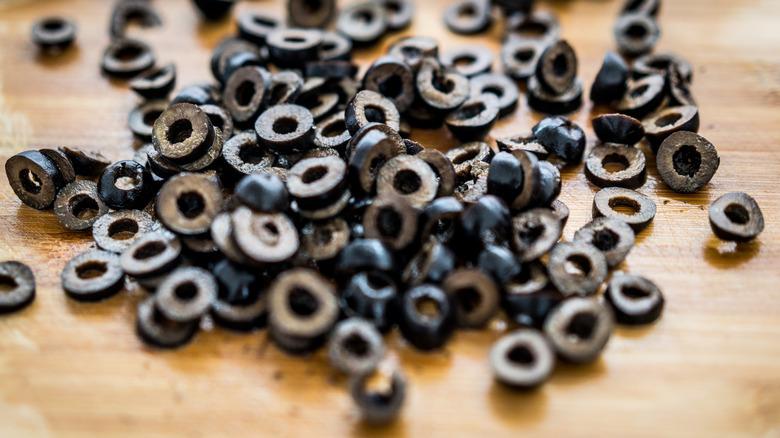Black Vs Green Olives: What's The Real Difference?
We may receive a commission on purchases made from links.
Olives are remarkable little ingredients. They've got a salty, sometimes sweet taste and they've long been a staple in Mediterranean, especially Greek, cuisine. They're also the perfect garnish for a dirty martini. Usually, though, you've got a choice between green and black olives at the store, so what makes them different? Even though there are different kinds of olives out there, green and black olives aren't different varieties of the fruit — olives are technically fruits, by the way, and they're considered stone fruits, like cherries or peaches, because of the pits they contain. Instead, an olive's color is a way to identify its age.
Green and black olives are the exact same food at different stages of ripening. Green olives are younger and underripe, while black olives have been aged for longer and are either ripe or overripe. They have slightly different tastes as a result, with green olives tasting more bitter and black olives taste milder. However, the way they're both prepared can also affect their taste, as both black and green olives are cured after being harvested to preserve whatever stage of ripening they're currently in. The curing also alleviates some bitterness and makes them safe to eat.
Green olives are more flavorful
Olives are a seasonal fall fruit, although their full harvest season can extend into winter. In particular, green olives are harvested early, with mid-September being an optimal time to pick green olives and begin preserving them before they can ripen into black olives. Due to being plucked from trees so early, the texture of a green olive is hard and dense, and has that aforementioned bright, bitter taste. Often, they're preserved slightly differently than black olives, as they're fermented in a lye (or alkaline) solution before being put into a salt brine. When a green ripe olive is ready to be harvested, it'll contain a pale juice which is commonly milky in color and texture.
Boasting a strong flavor, green olives are common choices for salads, pastas, and meat dishes, and they're the ones you'll always find served with a dirty martini. You can prepare stuffed olives filled with almonds or peppers, like Amazon Fresh's pimento stuffed olives, too. Just watch out for the pits: Whole olives with their pits intact are flavorful, but you'll need to spit them out. Both green and black olives can be used to make oil, but green olives are preferred for olive oil, because they give a bottle of extra virgin olive oil a more peppery, bright flavor.
Black olives are more mature
Much like plenty of other fruit — say, bananas, for instance — olives become less green as they mature and ripen. A green olive will change color to black after a few months on the branch. Accordingly, harvesting season for black olives (at least in the United States) typically happens later in November and goes into December. After they're picked, they're brined in water and salt. Unlike green olives, a fresh black olive will have a dark reddish juice instead of milky white juice. You shouldn't drink it, though — when people talk about using leftover olive juice, they mean the briny byproduct of preserved olives, which is salty but safe to use for cooking.
Black olives tend to taste less bitter and more savory, which makes them easier to blend into the background of a more complicated recipe. Chopped black olives are also a common pizza topping, and they're great choices for tapenade, a spread or dip made with capers and occasionally garlic or anchovies. Chopping olives can be slightly complicated because of the pits inside them: The trick is to flatten the olive, pop out the pit, and then take a knife and chop the remains. They're ready to put on your pizza or toss into a salad afterward — Greek salads often use black Kalamata olives. In some cases, though, store-bought black olives may have had their pits removed before canning.
The wide (Mediterranean) world of olives
Green and black may not refer to different types of olives, but there are different varieties of olives that can be served either ripe or unripe. Greek Kalamata olives, such as this jar of pitted ones from Whole Foods, are among the most popular, being originally grown in the Peloponnese region in southern Greece (specifically Messinia and Laconia). They're frequently served black in the aforementioned pizzas and salads. You're also likely to see large Ligurian or wrinkly Gaeta olives from Italy, which are more commonly served green. When it comes to Spanish olives, the buttery and mildly fruity Arbequina olives are most common and usually brined and served at a darker shade.
With all of that said, is there any major health difference between these olives whether they're eaten green or black? Not significantly, although olives do have different nutritional properties at different stages of maturity. Green olives are higher in protein, fiber, and antioxidants such as polyphenols. However, they are also significantly higher in sodium than black olives, although the brining processes for both certainly doesn't help. Black olives, on the other hand, have significantly more iron and vitamin C. Both black and green olives are packed full of vitamin E and antioxidants, though, so you shouldn't feel as though one type of olive is notably more nutritious than the other.



